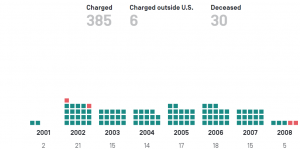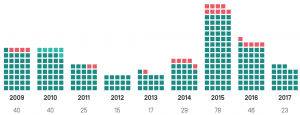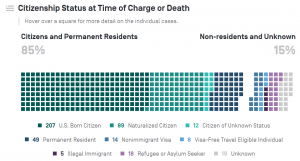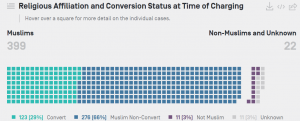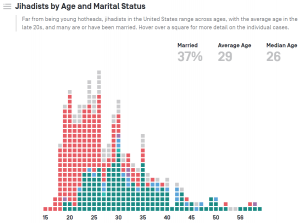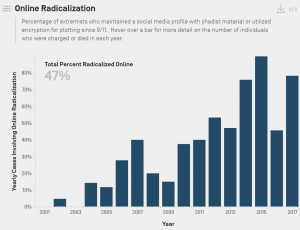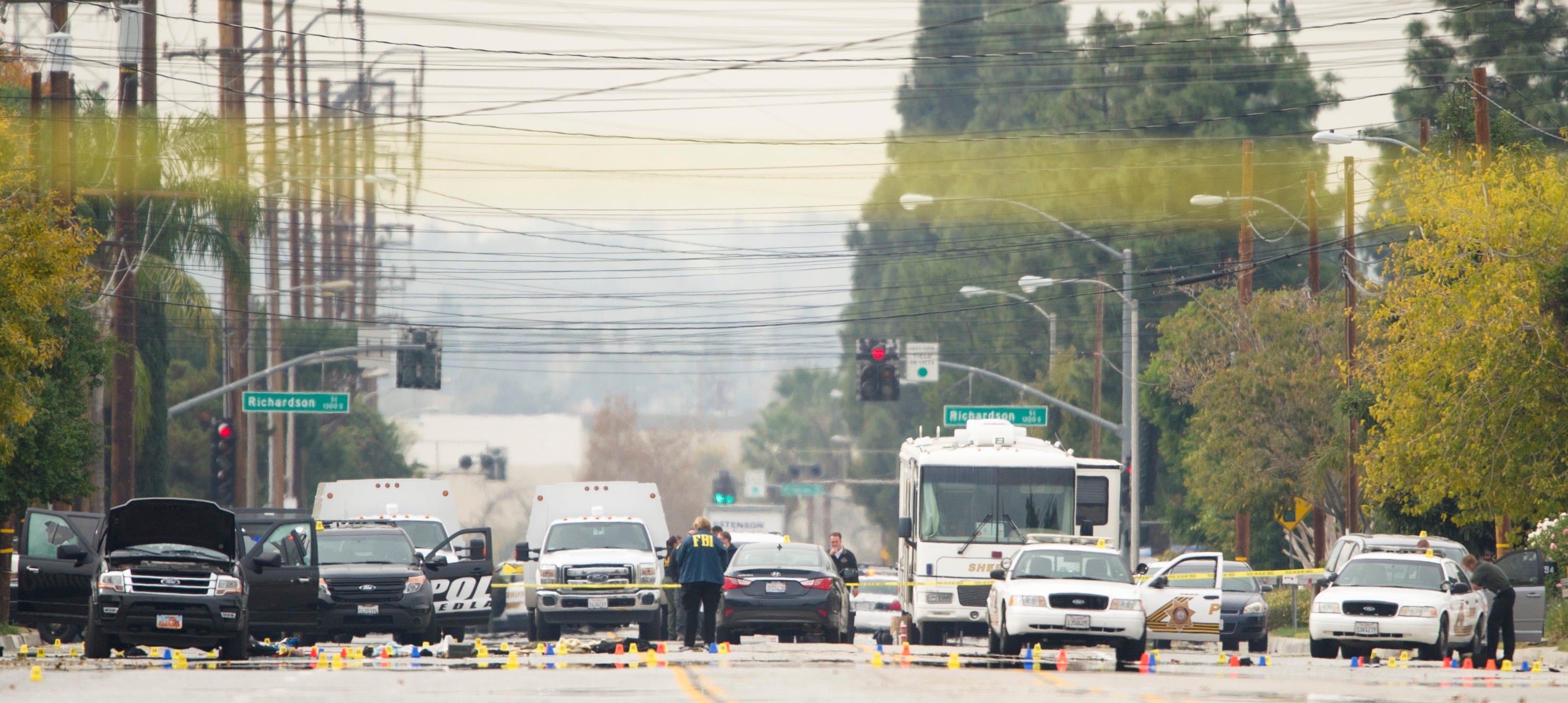
Photo: © Yang Lei/Xinhua/Alamy Live News
A comprehensive, up-to-date source of online information about terrorist activity in the United States and by Americans overseas since 9/11.
By (left-to-right) Peter Bergen, Albert Ford, Alyssa Sims, and David Sterman
Introduction
This In-Depth report from our International Security Program examines broad trends in the jihadist terrorist threat facing the United States that have emerged over the last 15 years. We provide an overview of the terrorism in cases we’ve tracked since 9-11, and we examine three key questions: Who are the terrorists targeting the United States? Why do they engage in terrorism in the first place? And what threat do they pose?
The data in this report consists of individuals accused of jihadist terrorism related crimes since 9/11 who are either American citizens or who engaged in jihadist activity within the United States. The data also include a small number of individuals who died before being charged but were widely reported to have engaged in jihadist criminal activity, We define jihadists to include those who are motivated by versions of bin Laden’s global ideology or otherwise provide support to groups that follow a version of that ideology. We exclude cases linked to Hamas, Hezbollah, and similar groups that do not follow bin Laden’s ideology and do not target the United States.
Part 1. Terrorism Cases: 2001-Today — Terrorist-related cases are on the rise in the United States, especially since the onset of the Syrian civil war.
Part 2. Who are the Terrorists? — Conventional wisdom holds that the jihadist threat is composed of foreigners or young, male hot-heads. The truth is more complicated.
Part 3. Why Do They Engage in Terrorism? — The motivations of jihadist extremists in America are difficult to disentangle, and easy explanations are often proven wrong.
Part 4. What is the Threat to the United States Today? — Most U.S. attacks are carried out by individuals inspired by jihadism, but with no direct involvement from abroad.
Part 1. Terrorism Cases: 2001-Today
Since 9/11, hundreds of Americans and people residing inside the United States have been charged with jihadist terrorism or related crimes, or have died before being charged but were widely reported to have engaged in jihadist criminal activity. In the past two years, the rise of ISIS has brought an unprecedented surge in terrorism cases though there have been cases every year since 9/11, as illustrated below (Click Images to Enlarge):
Part 2. Who are the Terrorists?
Photo: U.S. Government / Public Domain
They are as “American as Apple Pie”
In the post-9/11 era, conventional wisdom holds that the jihadist threat is foreign. The conventional wisdom is understandable; after all it was 19 Arab hijackers who infiltrated the United States and conducted the 9/11 attacks. Yet today, as Anwar al-Awlaki, the American born cleric who became a leader in Al Qaeda in the Arabian Peninsula, put it in a 2010 post, “Jihad is becoming as American as apple pie.” Far from being foreign infiltrators, the large majority of jihadist terrorists in the United States have been American citizens or legal residents. Moreover, while a range of citizenship statuses are represented, every jihadist who conducted a lethal attack inside the United States since 9/11 was a citizen or legal resident.
Far from being foreign infiltrators, the large majority of jihadist terrorists in the United States have been American citizens or legal residents. (Click Images to Enlarge):
The Trump Travel Ban and Lethal Attacks
On January 27, 2017 President Donald Trump issued an executive order banning entry from seven majority Muslim countries (Iran, Iraq, Syria, Sudan, Libya, Yemen, and Somalia) citing national security reasons. None of the deadly attackers since 9/11 emigrated or came from a family that emigrated from one of these countries nor were any of the 9/11 attackers from the listed countries. Eight of the lethal attackers were born American citizens. On March 6, 2017, the Trump administration issued a new executive order that dropped Iraq from the travel ban among other changes. In September 2017, the Trump administration again revised the ban, dropping Sudan while adding restrictions on travel from Chad, Venezuela, and North Korea.
Of the thirteen lethal jihadist terrorists in the United States since 9/11:
- three are African-Americans
- three are from families that hailed originally from Pakistan
- one was born in Kuwait to Palestinian-Jordanian parents
- one is a White convert born in Texas.
- two came from Russia as children
- one emigrated from Egypt and conducted his attack a decade after coming to the United States
- one emigrated from Uzbekistan
- and one each had families that originally came from Kuwait and Afghanistan
(Click Images to Enlarge)
What about Non-Lethal Attacks?
When the data is extended to include individuals who conducted attacks inside the United States that were foiled or otherwise failed to kill anyone, there are only three cases that the travel ban could have applied to. However, in two of those cases, the individual entered the United States as a child.
On March 3, 2006, Mohammed Reza Taheri-Azar, a naturalized citizen from Iran, drove a car into a group of students at the University of North Carolina, injuring nine people. However, Taheri-Azar, though born in Iran, came to the United States at the age of two. As a result his radicalization was homegrown inside the United States.
On September 17, 2016 Dahir Adan, a 20-year-old naturalized citizen from Somalia – though born in Kenya, injured ten people while wielding a knife at a mall in Minnesota. However, like Taheri-Azar, Adan had come to the United States as a young child.
On November 28, 2016 Abdul Razak Ali Artan, an 18-year-old legal permanent resident who came to the United States as a refugee from Somalia in 2014 — having left Somalia for Pakistan in 2007 — injured eleven people when he rammed a car into his fellow students on the campus of Ohio State University and then proceeded to attack them with a knife. However, it is not clear that the attack provides support for Trump’s travel ban. Artan left Somalia as a pre-teen, and if he was radicalized abroad, it most likely occurred while in Pakistan, which is not included on the travel ban. Furthermore, it is far from clear that Artan radicalized abroad rather than inside the United States, and in a Facebook posting prior to his attack, he cited Anwar al-Awlaki, the Yemeni-American cleric born in the United States, whose work — which draws largely upon American culture and history — has helped radicalize a wide range of extremists in the United States including those born in the United States. ((Click Images to Enlarge)
Many are Converts
A large proportion of jihadists in the United States since 9/11 have been converts. This is not entirely surprising as one in five American Muslims are converts according to a 2011 study by the Pew Research Center though converts do appear to be over-represented among jihadists. In addition a small number of cases involve non-Muslims, including those convicted in the Liberty City Seven case who were followers of the Moorish Science Temple, a syncretic religion combining aspects of Islam and other religions.
The large number of converts and even non-Muslims among those accused of jihadist terrorism challenges visions of counterterrorism policy that rely on immigration restrictions or focus almost entirely on second generation immigrant populations. (Click Images to Enlarge)
They’re Not All Young Hot Heads
Another misconception is that jihadist extremism is the province of only young hotheaded loners. Such individuals certainly exist, yet in the United States, participation in jihadist terrorism has appealed to individuals ranging from young teenagers to those in their advanced years. Many of those involved have been married and even had kids – far from the stereotype of the lone, angry youngster. (Click Images to Enlarge)
They’re Mostly Men, but Women are Increasingly Involved
Political violence broadly, and jihadist terrorism more specifically given the misogyny of the ideology, has long tended to be dominated by men. Unsurprisingly, jihadist terrorists in United States have fit this pattern, but more women have been accused of jihadist terrorism crimes in recent years.
Tashfeen Malik, along with her husband Syed Rizwan Farook, massacred 14 people in San Bernardino, California in December 2015. Malik is one of an increasing number of women involved in terrorist activities in the United States. (U.S. Government / Public Domain)
(Click Images to Enlarge)
Part 3. Why Do They Engage in Terrorism?
Photo: CRM / Shutterstock.com
Motivations are Complicated
The motivations of jihadists in the United States are difficult to disentangle. After reviewing hundreds of cases in this database, thousands of pages of court documents, and interviews and correspondence with extremists and their family members, it is far from clear there will ever be a straightforward answer. Complaints regarding American foreign policy certainly play some role as does religious ideology, but so do profoundly personal attributes. Some jihadists appear to follow understandable paths of radicalization while others don’t. Nor does it appear that the extremists are simply mentally ill or criminals. In the end, as Immanuel Kant put it, “From the crooked timber of humanity not a straight thing was ever made.”
Peter Bergen’s “Why Do Terrorists Commit Terrorism” in the New York Times, David Sterman’s “It’s foolish to try to simplify the motives of terrorists” in the Washington Post, as well as our report, “ISIS in the West,” delve further into some of the questions of motivation.
In Bergen’s article drawing upon the more than 350 terrorism cases in this database, he notes:
The easy explanation — that jihadist terrorists in the United States are “mad” or “bad” — proved simply wrong. Around one in 10 had mental health problems, below the incidence in the general population. Nor were they typically career criminals: Twelve percent had served time in prison, compared with about 11 percent of the American male population.
…Perpetrators (are) generally motivated by a mix of factors, including militant Islamist ideology; dislike of American foreign policy in the Muslim world; a need to attach themselves to an ideology or organization that gave them a sense of purpose; and a “cognitive opening” to militant Islam that often was precipitated by personal disappointment, like the death of a parent. For many, joining a jihadist group or carrying out an attack allowed them to become heroes of their own story.
As Peter Bergen notes in “Jihadist Terrorism 15 Years After 9/11”:
Even in the cases of the dozen perpetrators who carried out the ten lethal jihadist terrorist attacks in the United States since 9/11, only three of the terrorists had a documented history of mental illness.
Despite the difficulty of disentangling the motivations of jihadist extremists, a few key factors seem to tie together the many diverse and differently-expressed motivations of many of the extremists in this database. Specifically, the increasing role of social media and the Internet as a site of extremist activity and the role of particular ideologues in crafting messages to radicalize and recruit individuals.
The Importance of Social Media
The rise of social media as well as the use of the Internet more broadly to disseminate propaganda and connect people to extremist groups including encryption has reshaped the jihadist scene. Many extremists today either maintain public social media profiles displaying jihadist rhetoric or imagery or have communicated online using encrypted messaging apps. The percentage of cases involving such online activity has increased over time (Click Images to Enlarge):
The Influence of Anwar al-Awlaki
The rise of social media and the Internet as a force in the proliferation of jihadism in the United States was facilitated by a number of key figures who fine tuned the message and the distribution apparatus. Among them were Samir Khan, the North Carolinian who would come to edit Al Qaeda in the Arabian Peninsula’s (AQAP) propaganda magazine, Inspire, and Zachary Chesser, who became involved with Revolution Muslim, an organization that put out extremist propaganda via websites and YouTube videos, and made the infamous threat against the South Park television show creators. But the extremist with the most widespread influence was the American-born cleric Anwar al-Awlaki, whose influence continues to play a role in radicalization half a decade after his death in an American drone strike in Yemen.
Anwar al-Awlaki (left) and Samir Khan, editor of AQAP’s propaganda magazine Inspire. Both were killed in a U.S. drone strike. (File)
(Click Images to Enlarge)
Part 4. What is the Threat to the United States Today?
Photo: Flickr user: nostri-imago. Creative commons license.
The Threat is Not Existential
In the fifteen years after 9/11, jihadists have killed 95 people inside the United States. Each of those deaths is a tragedy. The attack in Orlando was the deadliest terrorist attack in the United States since 9/11 and the deadliest mass shooting in American history. However, the attacks are not national catastrophes of the type the United States experienced on 9/11. Instead the death toll has been quite similar to other forms of political—and even non-political—violence Americans face today. (Click Images to Enlarge):
America’s Layered Defenses
While the United States has seen a series of deadly attacks by individuals and pairs inspired by jihadism, the United States today is a hard target for foreign terrorist organizations, which have not directed and carried out a successful deadly attack in the country since 9/11. This is the result of a layered set of defenses including tips from local communities, members of the public, and the widespread use of informants.
New York tightened up security in Times Square after Faisal Shahzad attempted to detonate a car bomb on May 1, 2010. (Kenishirotie / Shutterstock.com)
A deadly attack directed from abroad cannot be ruled out. For example, the 2009 Christmas Day bomb plot by Umar Farouk Abdulmuttalab—who was trained and directed by Al Qaeda in the Arabian Peninsula—failed only because the explosive didn’t work. The Times Square bomb plot by Faisal Shahzad, who in 2010 managed to place a car bomb in Times Square undetected after training with the Pakistani Taliban, which again did not detonate properly, is another example. Despite these cases, the most likely threat continues to be lone individuals or pairs inspired by jihadist ideology without the type of extensive plotting, communication, or travel activity that would tip off the layered counterterrorism defense system.
Authors
Peter Bergen is a journalist, documentary producer, vice president at New America, CNN national security analyst, professor of practice at Arizona State University, and the author or editor of seven books, three of which were New York Times bestsellers and four of which were named among the best non-fiction books of the year by The Washington Post.
Albert Ford is a program associate with the International Security and Fellows programs at New America.
Alyssa Sims is a program associate with the International Security Program at New America.
David Sterman is a policy analyst at New America and holds a master’s degree from Georgetown’s Center for Security Studies.








